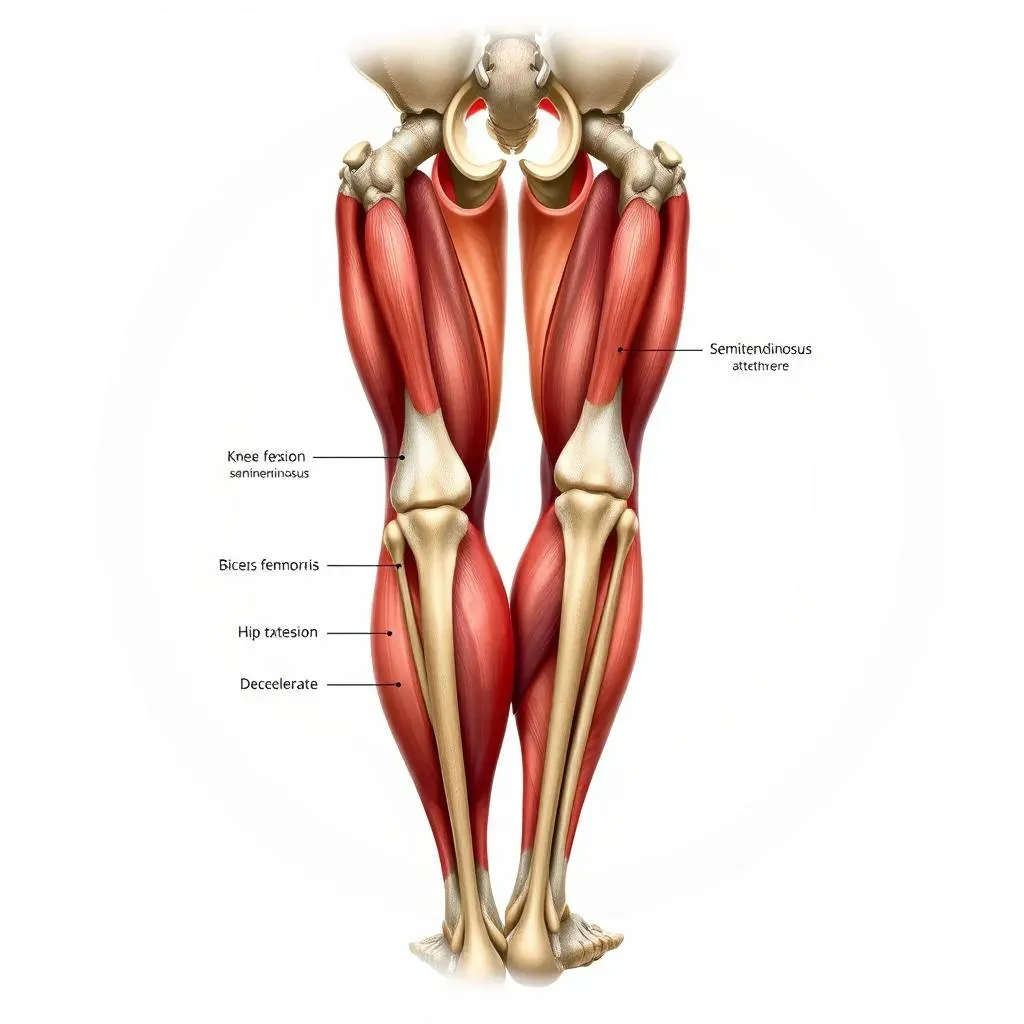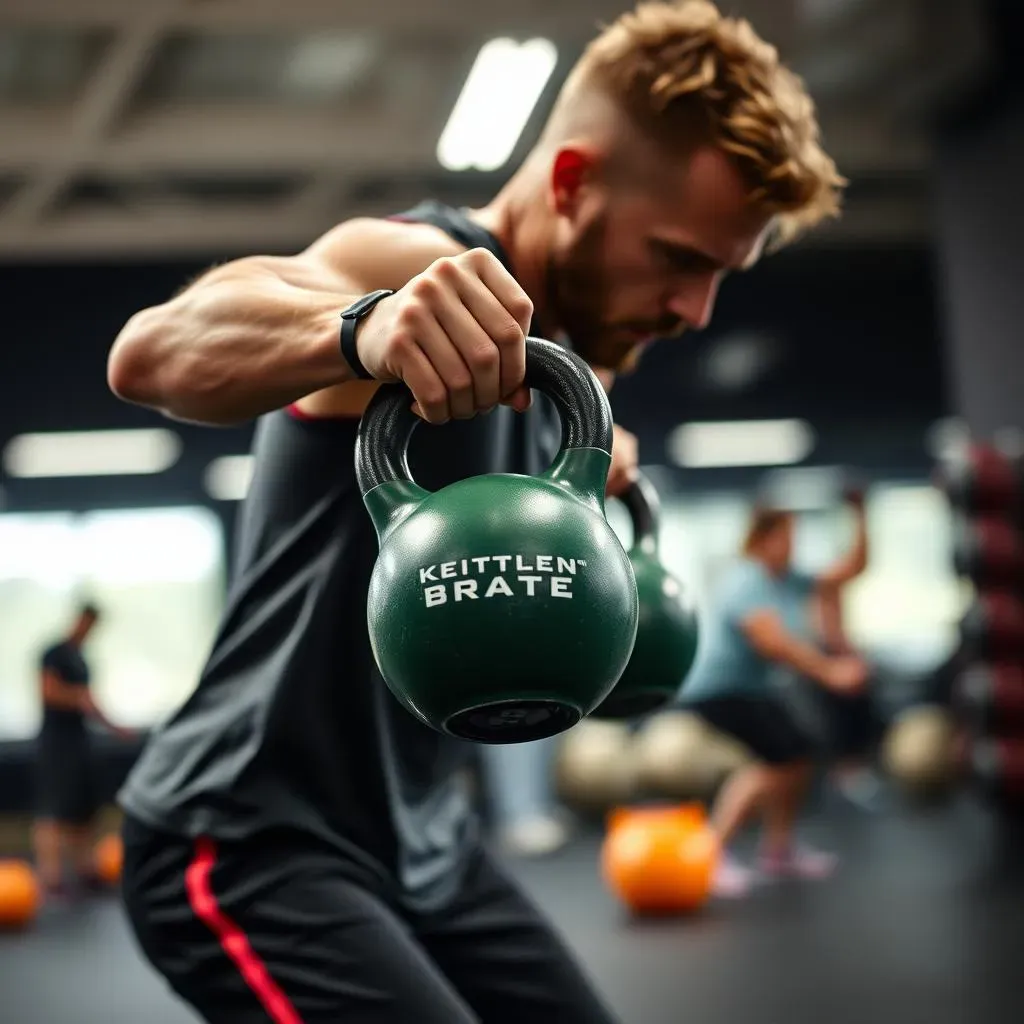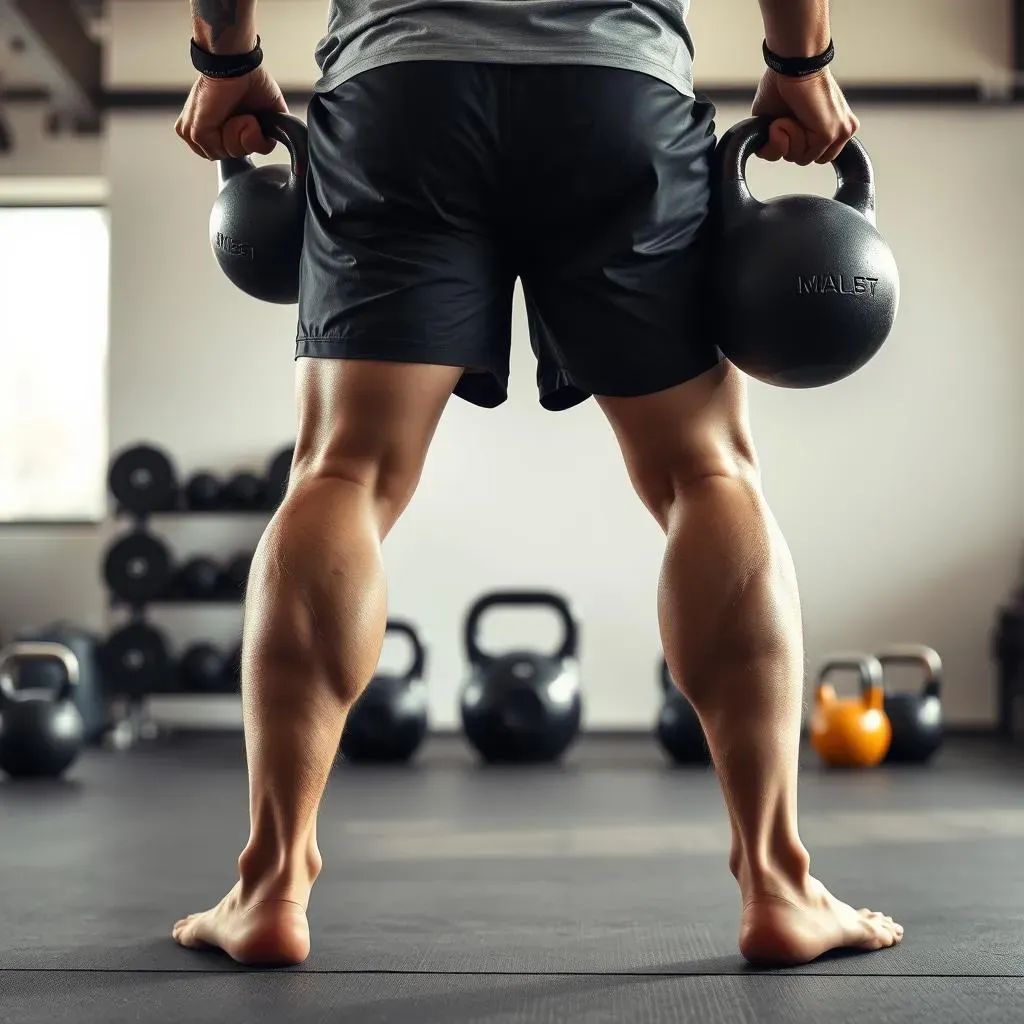Table of Contents
Are you a runner constantly battling tight hamstrings or nagging knee pain? Do you want to improve your speed and power on the road or trail? Then it's time to unlock the power of the hamstring kettlebell workout. Many runners focus on building quad strength, often neglecting their hamstrings, leading to muscle imbalances and increased injury risk. But fear not! This guide is your roadmap to a stronger, more resilient posterior chain. We'll dive into why hamstrings are so crucial for runners, explore the anatomy of these vital muscles, and reveal the incredible benefits of training them with kettlebells. Get ready to discover eight of the best kettlebell exercises specifically designed to target your hamstrings, from foundational movements like deadlifts to dynamic exercises like swings and lunges. Plus, we'll share expert tips to maximize your training and help you integrate these exercises seamlessly into your existing routine. So, lace up those shoes, grab a kettlebell, and let's get started on building stronger, healthier hamstrings for a more powerful run!
Why Runners Need Strong Hamstrings

Why Runners Need Strong Hamstrings
Preventing Injuries
Let's be real, nobody wants to be sidelined with an injury. For runners, strong hamstrings are your first line of defense against common ailments like hamstring strains, knee pain, and even lower back issues. Weak hamstrings put extra stress on your knees and other surrounding muscles, making you more susceptible to injury. Think of your hamstrings as the unsung heroes working hard to stabilize your legs with every stride.
Think of it this way: your quads are the gas pedal, propelling you forward, while your hamstrings are the brakes, controlling your leg's deceleration. If the brakes are weak, you're putting excessive strain on the joints and other muscles responsible for slowing you down. Strengthening your hamstrings helps create a more balanced and resilient lower body, allowing you to log more miles with less risk.
Improving Running Efficiency
Strong hamstrings aren't just about injury prevention, they're also about boosting your performance. Powerful hamstrings contribute to a more efficient running stride, allowing you to generate more force with each push-off. This translates to increased speed, improved endurance, and a more economical running style. When your hamstrings are strong, they work in synergy with your glutes to propel you forward, reducing wasted energy and maximizing your potential.
Imagine your hamstrings as the engine that drives your legs. The stronger the engine, the more power you can generate with each stride. By strengthening your hamstrings, you're essentially upgrading your engine, allowing you to run faster and farther with less effort. A strong posterior chain also helps maintain proper pelvic alignment, which is crucial for efficient running mechanics.
Benefit | Description |
|---|---|
Increased Speed | Stronger hamstrings generate more propulsive force. |
Improved Endurance | Efficient strides reduce wasted energy. |
Better Running Economy | Optimized biomechanics for less effort. |
Correcting Muscle Imbalances
Runners often develop quad-dominant legs, meaning their quadriceps are significantly stronger than their hamstrings. This imbalance can lead to a variety of problems, including increased injury risk and decreased performance. Strengthening your hamstrings helps correct this imbalance, creating a more harmonious relationship between the front and back of your legs. A balanced muscular system is essential for optimal biomechanics and injury prevention.
Think about it: if your quads are constantly overpowering your hamstrings, it's like driving a car with the parking brake on. You're working harder than you need to, and you're putting unnecessary stress on the system. By strengthening your hamstrings, you're releasing the parking brake and allowing your legs to work together more efficiently. This not only improves your running performance but also reduces your risk of developing overuse injuries.
Understanding Hamstring Muscle Anatomy

Understanding Hamstring Muscle Anatomy
The Three Amigos of the Hamstring
Alright, let's get down to the nitty-gritty. Your hamstrings aren't just one big muscle; they're a group of three muscles working together on the back of your thigh. These "three amigos" are the biceps femoris, semitendinosus, and semimembranosus. Each one plays a crucial role in both knee flexion (bending your knee) and hip extension (moving your leg backward). Knowing these muscles is the first step to understanding how to train them effectively.
Think of each muscle as a strand in a rope. The stronger each strand, the stronger the entire rope. When all three hamstring muscles are firing on all cylinders, you've got a powerful and resilient posterior chain ready to tackle any running challenge. Neglecting even one of these muscles can create weaknesses and imbalances, increasing your risk of injury.
Hamstring Attachment Points
Where a muscle attaches is super important because it dictates how it functions. The hamstrings originate from the ischial tuberosity (that bony part you sit on) and insert on the tibia and fibula (lower leg bones). This positioning allows them to act as both knee flexors and hip extensors, making them vital for running, jumping, and just about any lower body movement.
Because of their attachment points, they play a vital role in controlling hip and knee movement during running. They help decelerate the leg during the swing phase and contribute to the powerful push-off during the stance phase. Understanding these attachment points helps you visualize how the hamstrings work during different phases of the running gait.
Hamstring Function in Motion
Now, let's talk about what these muscles actually do when you're running. The hamstrings are responsible for flexing your knee, extending your hip, and controlling the deceleration of your leg as it swings forward. They work in opposition to your quadriceps, creating a balanced force that allows for smooth and efficient movement. They also play a role in pelvic stability, which is essential for maintaining proper running form.
Imagine your hamstrings as the shock absorbers of your legs. They help absorb the impact of each foot strike, protecting your knees and lower back from excessive stress. Without strong hamstrings, your body is forced to rely on other muscles and joints to compensate, increasing your risk of injury. Proper hamstring function is essential for a fluid and pain-free running experience.
Function | Description |
|---|---|
Knee Flexion | Bending the knee joint. |
Hip Extension | Moving the leg backward at the hip. |
Deceleration | Controlling leg swing and impact. |
The Benefits of a Hamstring Kettlebell Workout

The Benefits of a Hamstring Kettlebell Workout
Functional Strength for Real Life
Forget isolating muscles in a machine. A hamstring kettlebell workout builds functional strength, the kind that translates directly to everyday activities and, of course, running. Kettlebell exercises engage multiple muscle groups simultaneously, forcing your body to work as a cohesive unit. This is how your body moves in the real world, making kettlebell training incredibly effective for improving overall strength and coordination.
Think about picking up a heavy grocery bag or lifting a suitcase into the overhead compartment. These movements require a coordinated effort from your hamstrings, glutes, core, and back. Kettlebell exercises mimic these real-life movements, strengthening the muscles you use every day and making you more resilient to injury. Plus, the dynamic nature of kettlebell training improves your balance and stability, essential for navigating uneven terrain or unexpected obstacles.
Improved Hamstring-to-Quad Balance
We've already talked about how runners often develop quad dominance. Kettlebell training is an excellent way to address this imbalance and build a more balanced lower body. Many kettlebell exercises, such as deadlifts, swings, and lunges, specifically target the hamstrings, helping to strengthen them relative to the quads. This improved balance reduces your risk of injury and enhances your running performance.
Imagine your legs as a finely tuned machine. If one part is significantly stronger than the other, the machine won't function efficiently and is more likely to break down. By strengthening your hamstrings with kettlebells, you're fine-tuning your legs, ensuring that all the parts work together harmoniously. This not only improves your running performance but also reduces your risk of developing overuse injuries.
Benefit | Description |
|---|---|
Reduced Injury Risk | Balanced muscle strength protects joints. |
Enhanced Performance | Efficient movement improves speed and endurance. |
Improved Biomechanics | Optimal muscle function for smoother running. |
Enhanced Range of Motion and Flexibility
Kettlebell exercises often involve a wide range of motion, which can help improve your flexibility and mobility. Exercises like kettlebell swings and windmills require you to move through a full range of motion, stretching and strengthening your hamstrings simultaneously. This increased range of motion can improve your running stride and reduce your risk of muscle strains and tears.
Think about your hamstrings as elastic bands. The more you stretch and strengthen them, the more flexible and resilient they become. Kettlebell training helps you improve the elasticity of your hamstrings, allowing them to absorb more force and move more freely. This increased flexibility not only improves your running performance but also makes you feel more comfortable and mobile in your everyday life.
8 Kettlebell Exercises for a Killer Hamstring Workout

8 Kettlebell Exercises for a Killer Hamstring Workout
Kettlebell Good Mornings: The Hamstring Wake-Up Call
Let's kick things off with a classic: the Kettlebell Good Morning. This exercise is fantastic for warming up your hamstrings and improving hip hinge mechanics. Stand with your feet shoulder-width apart, holding the kettlebell in front of your chest. Keeping your back straight, hinge at your hips, pushing your glutes back as if you're closing a car door with your butt. Lower your torso until you feel a stretch in your hamstrings, then slowly return to the starting position. Remember, it's a hinge, not a squat!
Think of this as a gentle stretch with added resistance. The kettlebell helps to deepen the stretch and engage your hamstrings more effectively. Focus on maintaining a straight back throughout the movement to avoid any strain on your lower back. Start with a light kettlebell and gradually increase the weight as you get stronger. Aim for 2-3 sets of 10-12 reps.
Single Arm Kettlebell Deadlift: Unilateral Hamstring Power
Time to level up with the Single Arm Kettlebell Deadlift. This exercise not only targets your hamstrings but also challenges your core stability and balance. Stand with your feet hip-width apart, placing the kettlebell on the outside of one foot. Hinge at your hips, keeping your back straight, and reach down to grab the kettlebell with one hand. Engage your core and drive through your heels to stand up, squeezing your glutes at the top. Lower the kettlebell back down with control, maintaining a straight back throughout the movement.
The single-arm variation adds an extra challenge to your core, forcing it to work harder to stabilize your body. Focus on maintaining a neutral spine and avoiding any twisting or rounding of your back. Start with a lighter kettlebell and gradually increase the weight as you get stronger. Aim for 2-3 sets of 8-10 reps per side.
Kettlebell Swings: Explosive Hamstring Power
No kettlebell hamstring workout is complete without the Kettlebell Swing. This exercise is a powerhouse for building explosive hamstring power and improving your cardiovascular fitness. Stand with your feet shoulder-width apart, with the kettlebell a few inches in front of you. Hinge at your hips, reach down to grab the kettlebell with both hands, and hike it back between your legs. Engage your core and drive through your hips to swing the kettlebell forward, keeping your arms straight. Allow the kettlebell to swing back down between your legs, and repeat the movement.
The key to a good kettlebell swing is the hip hinge. The power should come from your hips and glutes, not your arms. Think of your arms as ropes that are simply guiding the kettlebell. Focus on maintaining a straight back and engaging your core throughout the movement. Start with a lighter kettlebell and gradually increase the weight as you get stronger. Aim for 3-4 sets of 15-20 reps.
Exercise | Sets | Reps |
|---|---|---|
Kettlebell Good Mornings | 2-3 | 10-12 |
Single Arm Kettlebell Deadlift | 2-3 | 8-10 (per side) |
Kettlebell Swings | 3-4 | 15-20 |
Tips for Maximizing Your Hamstring Kettlebell Workout

Tips for Maximizing Your Hamstring Kettlebell Workout
Alright, you've got the exercises, now let's talk strategy. A hamstring kettlebell workout isn't just about flailing around with a weight; it's about being smart, consistent, and listening to your body. To truly maximize your results and minimize your risk of injury, there are a few key principles to keep in mind. Think of these as the secret sauce that will take your hamstring training to the next level. We are talking about variety, functional movement, unilateral work and full range of motion.
Conclusion: Kettlebells for Stronger, Healthier Hamstrings
Incorporating a hamstring kettlebell workout into your training regimen can be a game-changer for runners. By strengthening your posterior chain, you'll not only reduce your risk of injury but also unlock new levels of power and efficiency in your stride. Remember to prioritize proper form and gradually increase the intensity and volume of your workouts. Start by adding one or two of these exercises to your routine two to three times per week and listen to your body. With consistent effort and a focus on functional movement, you'll be well on your way to achieving stronger, healthier hamstrings and a more enjoyable running experience. So, keep swinging, lunging, and deadlifting your way to success!